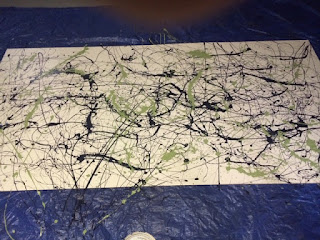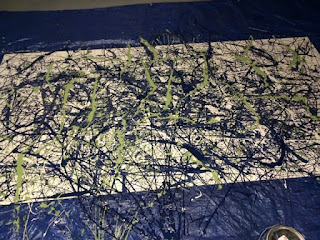I went through a phase, after seeing the Jackson Pollock bio-pic, of being fascinated with this artist.
Going so far as wondering if a writer could write like Pollock painted. The closest thing to it might be James Joyce's
Finnegan's Wake.
Here's just a little sampling of Joyce's enigmatic "novel": (yes, this is supposedly in English)
Sir Tristram, violer d'amores, fr'over the short sea, had passen-core rearrived from North Armorica on this side the scraggyisthmus of Europe Minor to wielderfight his penisolate war: norhad topsawyer's rocks by the stream Oconee exaggerated themselseto Laurens County's gorgios while they went doublin their mumperall the time: nor avoice from afire bellowsed mishe mishe totauftauf thuartpeatrick: not yet, though venissoon after, had akidscad buttended a bland old isaac: not yet, though all's fair invanessy, were sosie sesthers wroth with twone nathandjoe. Rot apeck of pa's malt had Jhem or Shen brewed by arclight and roryend to the regginbrow was to be seen ringsome on the aquaface.
Now, I'm quite certain that Joyce and Pollock came at this very differently, but there's no denying that Joyce's is as much a seeming word salad as Pollock's technique got him pegged with the nickname "Jack the Dripper."
Some critics just can't see genius.
Anyway, I wanted to try to make a painting like Pollock's and, after many attempts, I figured out his technique: Layers!
If you just keep splashing wet paint into wet paint, you'll have a mess. If you slowly apply layers and let them dry, you'll have the feeling of depth that can be found in Pollock's work. Here's my finished product:
See the various stages of this painting below.
Kind of like with writing, each layer is a draft. The first draft is very thin. Subsequent drafts start to show the painting emerging. Some drafts, just like with edits, seem to destroy the painting. Then more layers seemingly "save" the painting.
How do you know when you're done? Well, when asked the same question, Pollock responded, "How do you know when you're done making love?"
That answer emphasizes the very naturalistic approach Pollock had to his paintings.
Well, enjoy (and perhaps think about doing one of these yourself for creative output in between writing)
Oh, this is painted on a 4-foot by 8-foot wall panel sheet (about $20 from Home Depot). Then, I built a frame for it (another $15)
The paint was just leftover house paint from various projects. I did want to add that there's a purpose to this as a writer. Whenever I was going through a dry spell (the dreaded "writer's block"), I found that focusing on something else would get the writing blood flowing. I would often go down to the basement and do a layer just before writing. I'm not a painter, so I really found myself freed up when working on one. There was nothing on the line, and I tried to bring that same energy back to my writing... "just enjoy the process of creating!"
I was so fixated on painting for awhile that I wrote a novel about a painter you can get: here
If you find my blog posts instructive, please consider purchasing a copy of my new book of short stories, The Neighborhood Division, as a donated payment for the "class."
From the Publisher (preferred):
here
A review of the book:
here




























My sister used to paint in acrylics. Well, I did too, but her paintings sold for better prices than mine. Sometimes her mixing palette looked like a work of art in itself.
ReplyDeleteThank you for sharing! I believe Pollock worked with acrylics too. I mainly use latex house paints, just whatever is lying around.
ReplyDelete